Motorola Droid Bionic Review - Dual Core with 4G LTE
by Brian Klug on October 11, 2011 1:55 AM EST- Posted in
- Smartphones
- LTE
- Motorola
- OMAP 4
- Mobile
- motorola droid bionic
WiFi, GPS, Audio
The Motorola Droid Bionic, like the Droid 3, uses a TI WL1285 wireless combo for WLAN, Bluetooth, and an FM radio, were the Bionic to have an application for it. WiFi range on the Bionic is totally adequate, I can find nothing to fault with this, and we’ve pointed out where the WLAN antenna is on the device. Things are pretty standard here, the Bionic does a good job hopping on and off of my 2.4 GHz 802.11n network, and with my 20 MHz channels I see a link speed of 65 Mbps, which indicates long guard intervals.
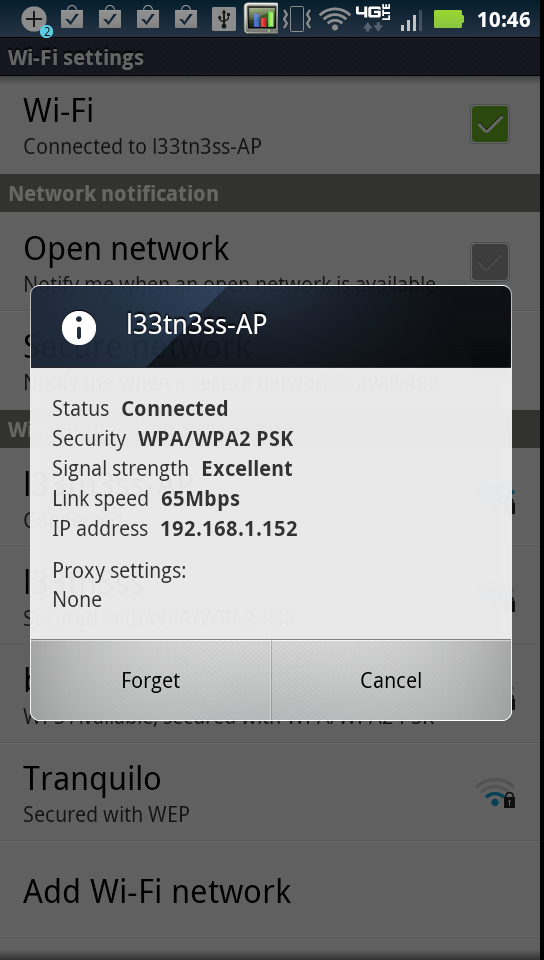
I did the usual thing and ran our local WLAN test which consists of downloading a locally-stored 100+ MB PDF and measuring throughput.
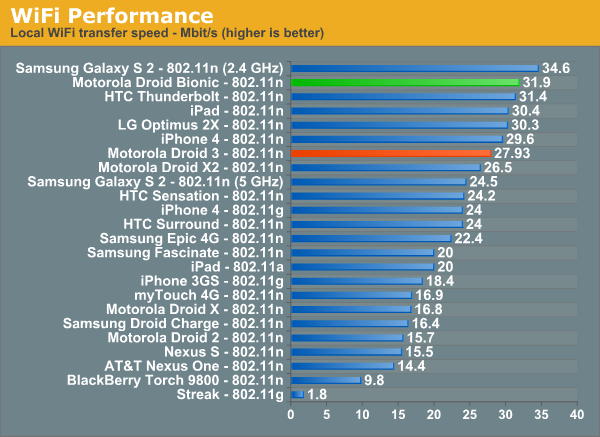
Performance here is on par with and slightly better than the Droid 3.
WiFi Hotspot
The Bionic also includes the requisite WiFi hotspot functionality you’d expect from a top tier smartphone. There are a maximum of five allowed wireless clients that can attach at a time. The software configuration thankfully also allows users to choose what wireless channel the hotspot sits on, and the DHCP server pool’s starting address. You can use WPA2 PSK or no encryption at all.
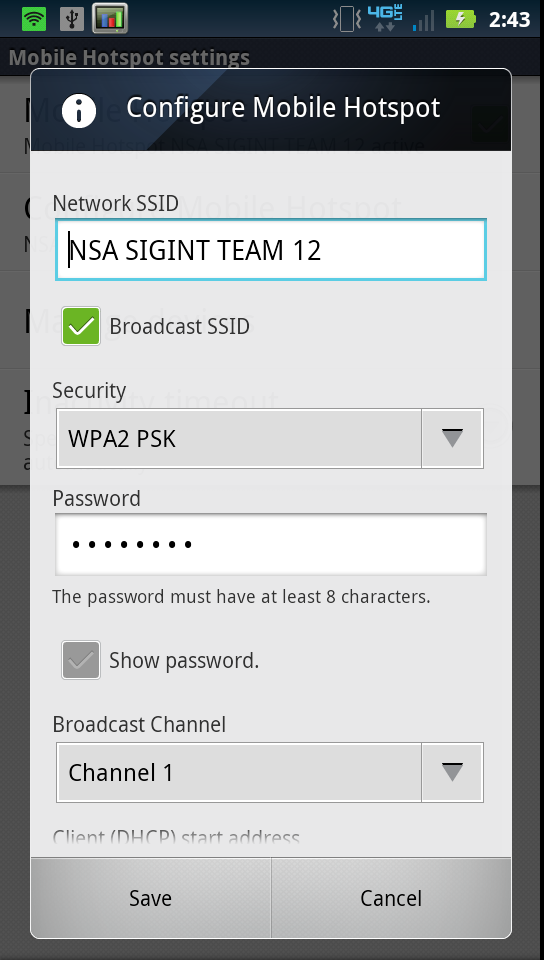
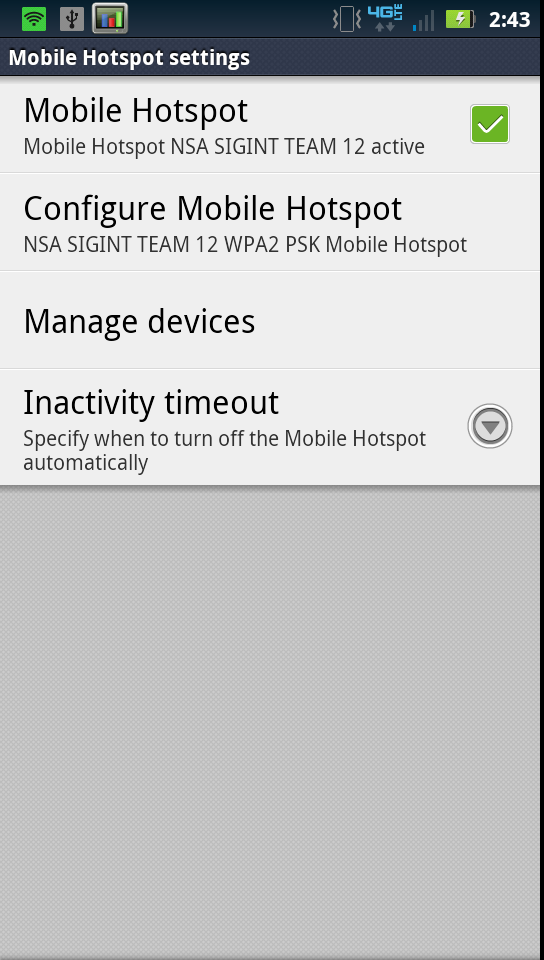
Clients attach and negotiate an 802.11g 54 Mbps link rate at maximum. I did have some initial stability problems with the Bionic when running our WiFi hotspot test, which I eventually tracked again to data saver during those night hours. Other than that, the hotspot works decently well. Just keep in mind that even connected to the charger, heavy WiFi hotspot use can discharge the phone slowly.
GPS
The Bionic uses Qualcomm’s GPSOne onboard MDM6600 and locks very fast and accurately, even indoors. Since Qualcomm’s GPS seems to be somewhat further abstracted away than most, I have a feeling every fix is warm rather than cold which helps speed things along considerably.
I’m impressed with the speed and robustness of the GPS on the Bionic it’s largely the same that I saw on the Droid 3.
Noise Cancelation and Audio
The Bionic, just like the Droid 3, has a total of three microphones. Two on the back of the device, one at the top, one at the bottom, and on the front, the primary microphone at the bottom. The Bionic, like the Droid 3, does some common mode noise rejection to reduce ambient noise when on calls, the result is that the other party in theory hears less background noise even if you’re in a noisy environment.
The Bionic performs about as well as the Droid 3, doing a good job filtering out background music when in close proximity to a speaker. I’ve recorded a sample showing this behavior the same way we’ve done before - I increase the volume, then decrease it, while talking, and record on another phone connected to line-in. I subjectively remember the Droid 3 doing a bit of a better job, but I have little doubt the Bionic uses the same solution, though I’m not sure whose IP this is.
Actual in-call audio is the same as well, I found the Bionic handset pleasing and decently loud. The Bionic does a good job making EVRC voice (which is what Verizon uses by default) sound actually pretty decent, and the earpiece doesn’t saturate or crackle at maximum volume. I’ve also recorded another sample with the Bionic calling the local ASOS.
The Bionic’s weak point is audio quality for listening to music. I’m still working with Francois to build out our audio testing suite. Unfortunately the Bionic’s main problem is blatant enough to be audible without doing objective testing. Just like the Galaxy S 2, the Bionic exhibits background hiss and whine that seems to be reflective of CPU frequency and current power draw. I’ve recorded a sample of this background whine that happens whenever the audio codec is on. You can hear the frequency of that background hiss change as I run a speedtest and keep the LTE radio active. It’s unfortunate because this is one of those - once you notice it, you can’t un-notice it - annoyances that really makes listening with sensitive in-ear monitors annoying.
The Bionic, just like the Droid 3, uses ST-E’s 3.1 CPCAP which is a combination PMIC, audio codec, and really an integrated solution for system management. I don’t have much hope for this being remedied with an external headset amplifier, as just like SGS2 you end up amplifying noise that exists even at 1/10 or 2/10 volume settings.
Speakerphone on the Bionic is supplied courtesy of what’s under that grille on the back in the lower left. The Bionic doesn’t saturate at maximum volume, but doesn’t go particularly loud either. Volume is very close to the Droid 3.
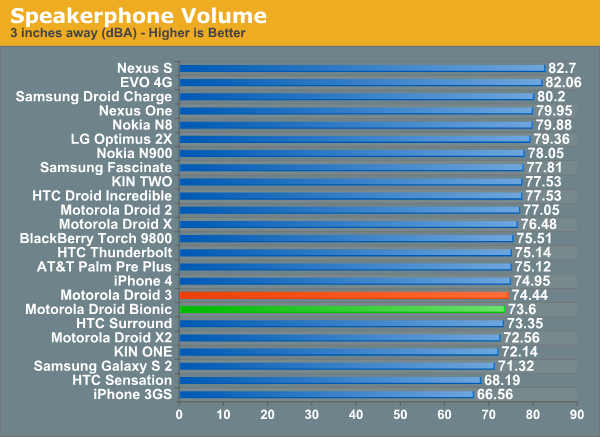


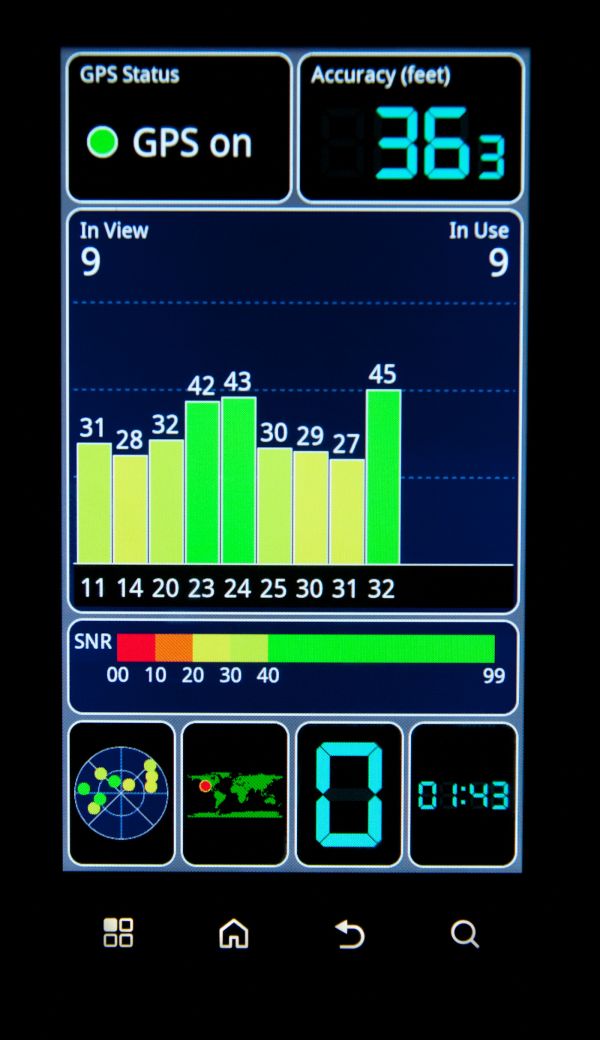








64 Comments
View All Comments
steven75 - Tuesday, October 11, 2011 - link
Except for the waiting for your battery to charge, as proven in the tests above.Omega215D - Tuesday, October 11, 2011 - link
Not all of us have that issue with LTE. Granted the battery life isn't something worth writing home about but it's sufficient, especially after receiving Gingerbread on my Thunderbolt. On my original Droid and my brother's iPhone 4 there were times when the system would be pegging the EVDO constantly when loading some web pages thus putting more strain on the battery.kepler - Tuesday, October 11, 2011 - link
I would be interesting to see how much data is consumed during the tests. If the LTE phone is consuming 4x the data, but lasting half the time, that is arguably 2x increase in possible productivity.Aikouka - Tuesday, October 11, 2011 - link
I'm assuming that there isn't much difference between the data. LTE modems simply seem to be power hungry, so running a constant stream of data will show pretty high battery use.This knowledge is good for some users, because for people that like to stream things like Pandora, they may consider turning off LTE (LTE isn't really required for streaming music). But what came to my mind while reading the article is that **constant data use tests** don't necessarily mimic the actions that all users take.
It'd be interesting if we could see power characteristics related to a single action. For example, how many YouTube videos could I load throughout a single charge of the battery? If the LTE-equipped phones can load 200 vs. 50 on EVDO (completely made-up numbers) simply because LTE provides significantly faster speeds, then that shows a rather large multimedia advantage.
Even without such a test, I think it's pretty easy to see that while LTE is pretty amazing to see in a phone... there's a lot of micro-managing that you may have to consider doing to see the sort of battery life that we've come to expect out of a phone.
secretmanofagent - Tuesday, October 11, 2011 - link
One thing that I would like to point out (and I think it's specific to Blur and worth mentioning) is the ability to dismiss individual notifications instead of having to open each individual notification or clearing all of them. I love that feature on the Bionic.I have seen some data connectivity issues with it where I will randomly lose all data and be unable to recover it until I reboot the phone (airplane mode doesn't fix it). This can happen at any point in the day or night, and I'm having my phone exchanged.
anandtech pirate - Tuesday, October 11, 2011 - link
nah, that's okay. we don't wanna see your face.... :-palmost all phone reviews only show the phone which is what people are watching to see.
LordConrad - Tuesday, October 11, 2011 - link
My Thunderbolt is rooted and running Andriod 2.3.4, courtesy of Das BAMF 3.0 RC4.9 rom.I've overclocked it from 1.0GHz to 1.2GHz
A few benchmark results:
Sunspider = 3092ms
GUImark 2 (fullscreen) = 48.32
LinPack (single-thread) = 44.831
GLbench 2.1 Egypt = 18.2
I'll stay with this until Qualcomm Krait gets here. Besides, I would much rather have a TFT screen at WVGA than a Pentile screen at qHD.
Omega215D - Tuesday, October 11, 2011 - link
Let's see what the Samsung Prime and the HTC Vigor have in store for us now that they are using HD screens.I have the OTA Gingerbread on my Thunderbolt. I get similar results without rooting or overclock. Battery life is longer as well. I just have to avoid downloading useless apps from the market though (thanks to a certain APK).
LordConrad - Tuesday, October 11, 2011 - link
I'm looking forward to the HTC Vigor also. I don't care for Samsung devices, the screens are nice but they feel cheap and are not as easy to root as newer HTC phones. The Thunderbolt was annoying to root and I'm not doing that again.I forgot to mention that I got the 3200mah extended battery from Seidio Online shortly after buying the phone. Also, the main purpose of rooting was to enable programs such as WiFi Tether. I refuse to pay an extra $30 for tethering since I never exceed my phone's 2GB data plan (tethering is only occasional).
jeepdinger - Tuesday, October 11, 2011 - link
I would be curious to see the number of times each page loads when the battery test is run. It was stated that several pages load continuously during the test. The new LTE speeds versus the slower 3G speeds should manage the same or more page loads for the same or less battery life. If this were true then there is a definite advantage to the LTE speeds even though the battery life seems less when the pages are continuously loaded. Is this something that could be added to the graphic, maybe as 2 bars per phone listed. Thanks.